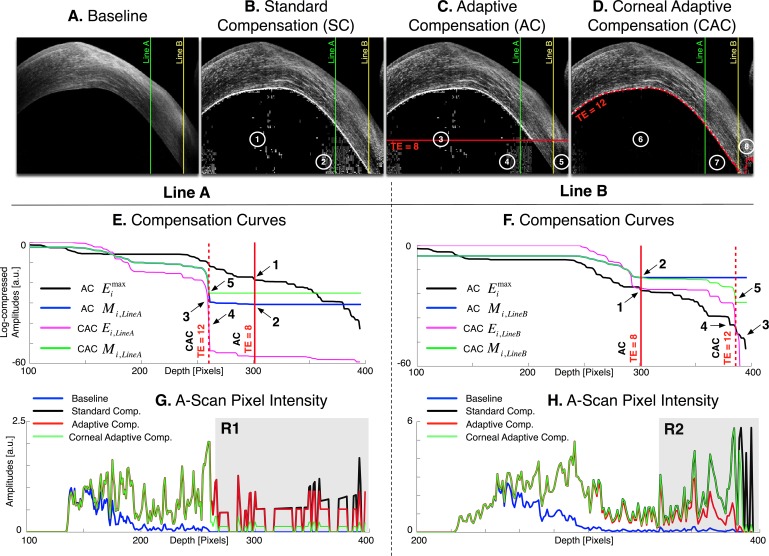Figure 7.
Images (A–D): Baseline, standard, adaptive, and corneal adaptive compensation images with a contrast exponent of n = 2 (cornea of subject #4). The adaptive maximum penetration depth istop is plotted as a horizontal red line (for TE = 8), and the corneal adaptive maximum penetration depth  as a dashed red curve (for TE = 12); Regions 1 to 4: areas over-amplified by the standard and adaptive compensation methods; Regions 6 to 8: over- and underamplifications have been avoided using depth-dependent amplification limits. Vertical lines indicate the A-scans A (j = 571; in green) and B (j = 713; in yellow) used for (E–H). Plots (E, F): examples of global penetration profile (
as a dashed red curve (for TE = 12); Regions 1 to 4: areas over-amplified by the standard and adaptive compensation methods; Regions 6 to 8: over- and underamplifications have been avoided using depth-dependent amplification limits. Vertical lines indicate the A-scans A (j = 571; in green) and B (j = 713; in yellow) used for (E–H). Plots (E, F): examples of global penetration profile ( ), adaptive compensation curve (ACMi,j), corneal penetration profile (CAC Ei,j) and corneal compensation curve (CACMi,j) for A-scans A (E) and B (F); Arrow 1: maximum penetration depth istop estimated from the adaptive global-penetration profile; Arrow 2: adaptive compensation stopped at istop; Arrow 3: depths where amplification should be stopped (as those correspond to the corneal endothelium); Arrow 4: corneal adaptive maximum penetration depth
), adaptive compensation curve (ACMi,j), corneal penetration profile (CAC Ei,j) and corneal compensation curve (CACMi,j) for A-scans A (E) and B (F); Arrow 1: maximum penetration depth istop estimated from the adaptive global-penetration profile; Arrow 2: adaptive compensation stopped at istop; Arrow 3: depths where amplification should be stopped (as those correspond to the corneal endothelium); Arrow 4: corneal adaptive maximum penetration depth  estimated using the line-dependent penetration profile CAC Ei,j; Arrow 5: corneal amplification CACMi,j stopped at
estimated using the line-dependent penetration profile CAC Ei,j; Arrow 5: corneal amplification CACMi,j stopped at  . This latter is automatically adjusted for shallow (E) and deeper tissues (F). Plots (G, H): Examples of baseline Ik,j and compensated A-Scans
. This latter is automatically adjusted for shallow (E) and deeper tissues (F). Plots (G, H): Examples of baseline Ik,j and compensated A-Scans  ,
,  , and
, and  for the lines A (E) and B (F). R1: region overamplified by both standard and adaptive methods, but correctly handled by the corneal adaptive approach; R2: region underamplified by the adaptive compensation approach, but well amplified by the corneal adaptive compensation.
for the lines A (E) and B (F). R1: region overamplified by both standard and adaptive methods, but correctly handled by the corneal adaptive approach; R2: region underamplified by the adaptive compensation approach, but well amplified by the corneal adaptive compensation.

